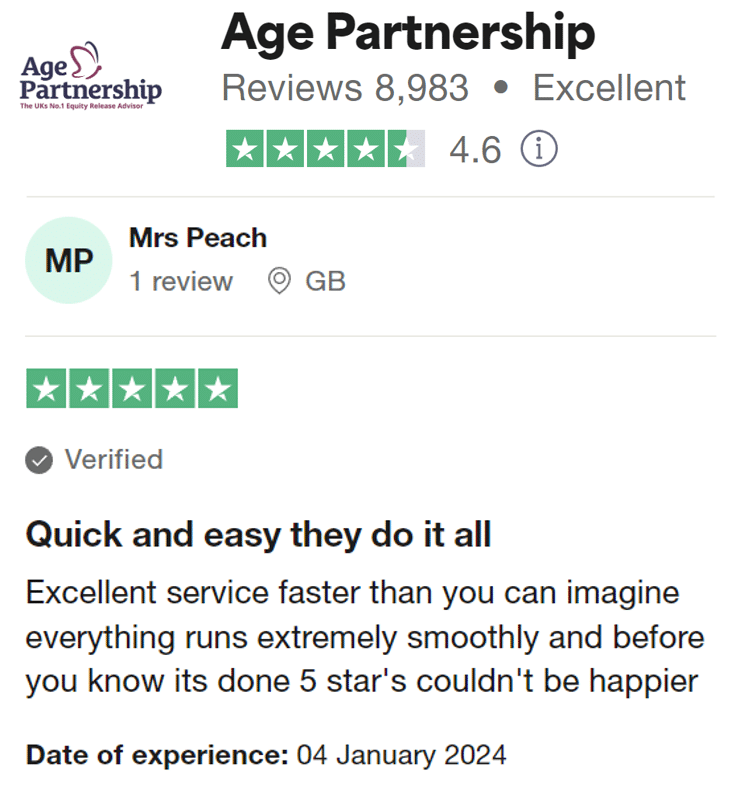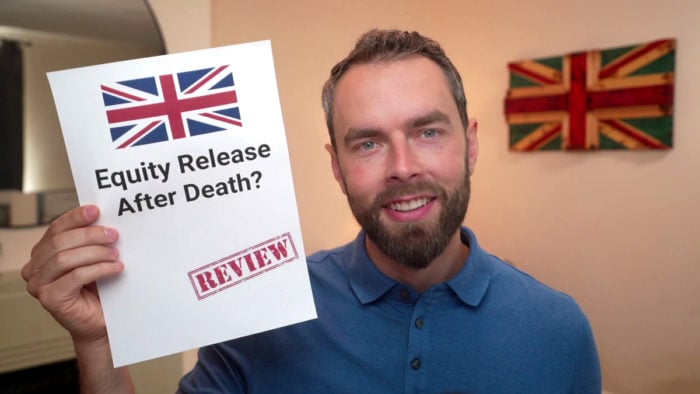What is Drawdown Equity Release? Overview, FAQs & Tips
Our preferred equity release adviser is Age Partnership. For free and impartial money advice you can visit MoneyHelper.

Our preferred equity release adviser is Age Partnership. For free and impartial money advice you can visit MoneyHelper.
Do you want to know more about drawdown equity release? We’re here to help. Each month, over 7,000 people visit our website to learn about equity release. We understand it can be a bit tricky to know what’s what, so we’re here to make it easy for you.
In this article, we’ll talk about:
- What equity release is and how it works.
- Who can use equity release and how to get a realistic quote.
- The benefits of equity release, especially drawdown equity release.
- The interest rates for drawdown equity release.
- How drawdown equity release might affect your benefits or taxes.
We know that your home’s equity is precious to you. It’s important to make sure you understand everything before you make a big choice. We’ve got lots of advice to guide you from the start to the finish.
Let’s dive in.
How does it work?
Equity release works through a lifetime mortgage or home reversion scheme.
Lump-sum lifetime mortgage
Equity release predominantly works through a lifetime mortgage. This is a lump-sum loan taken out against your property that charges a fixed interest rate. As mentioned, neither the loan nor interest has to be repaid each month, and so the interest adds to the total debt over time.
To provide some perspective, taking out a £65,000 lifetime mortgage at a 6.4% interest rate would equal a debt close to £137,000 after just 12 years. The debt can mount up quickly, which is why it’s important to only consider lifetime mortgages from lenders that are members of the Equity Release Council. As members, they agree to never recover more than the sale proceeds of the property – any remaining debt is not chased. This is called the negative equity guarantee.
You can also find enhanced lifetime mortgages specifically offered to help people with a shorter life expectancy access even more equity as a lump sum. These Involve health questionnaires and you might have to send copies of medical records to the lender. No additional medical or examination should be required.
Lump-sum home reversion scheme
Another method of releasing equity is through an equity release plan called a home reversion scheme. These equity release plans do not charge any interest usually. To make a profit on the loan, the lender asks that you give up a greater percentage of your property’s sale proceeds in the future, compared to the amount of equity you release. For example, you may take a loan worth 20% of the value of your property but must give up 60% when it is sold.
Thus, both methods can be expensive and eat into the value of the homeowner’s estate.
» TAKE ACTION NOW: Find out how much equity you could release
Who can use it?
Equity release can be used by senior homeowners who own their own home outright, i.e. with no existing first or second charge mortgage. The home must meet the lender’s minimum value, which is typically around £70,000.
Equity release also requires both homeowners to meet the lender’s age requirement. The minimum age requirement usually starts at 55 but can be as high as 65.
What does a drawdown mean?
Drawdown equity release is when the homeowner does not receive their home equity as a lump sum loan. Instead, they receive a facility that allows them to take their total amount in instalments over time.
How does it work?
Drawdown equity release works by giving the homeowner full control over how much they withdraw from their drawdown facility and when. For example, if you released £40,000 equity, you might decide to draw down £1,000 per month for the next 40 months. Or you may decide to take out £20,000 per year for the next two years. You’ll probably need to take out an initial lump sum at first so the lender can begin charging some interest.
Always check the terms and conditions of your drawdown equity release plan to see if there are any restrictions on how you use the drawdown facility.
How equity release could help
More than 2 million people have used Age Partnership to release equity since 2004.
How your money is up to you, but here’s what their customers do…
Find out how much equity you could release by clicking the button below.
In partnership with Age Partnership.
Lifetime mortgages
Drawdown lifetime mortgages work in the same way as any other lifetime mortgages, but as the name suggests, you get the money through a drawdown facility instead of a lump sum. The loan you receive is still tax-free cash.
There is a cost-effective benefit of using a drawdown lifetime mortgage. As a fixed interest rate is charged on the amount received, you can mitigate how much interest is added to your total debt by using drawdown lifetime mortgages over cash lump sum lifetime mortgages.
As opposed to having a lump sum sit in your bank and not get used for a while, you can avoid paying as much interest on it by only drawing down on what you plan to spend in the immediate future.
Home reversion schemes
A drawdown home reversion scheme works the same as a regular home reversion scheme that pays a lump sum. But as you guessed, the tax-free cash is supplied through a drawdown facility. As most reversion plans don’t charge interest, there is no cost-effective benefit of choosing a drawdown version.
However, it can still help budget for large home renovation projects. And there is an additional benefit of choosing drawdown equity release over lump sum equity release to do with means-tested benefits. We’ll return to this later.
Interest rates
Drawdown lifetime mortgage interest rates are more likely to be variable rates than fixed rates, giving the lender greater control over how much interest is charged over time. However, you may still find some fixed interest rates when taking out a drawdown lifetime mortgage.
At the time of writing, the lowest interest rates range from 4% to 10%. But these are subject to change.
How common is it?
Drawdown lifetime mortgages are just as common as other lifetime mortgages that provide the money in one payment. Many people prefer having a cash reserve rather than releasing all their equity in one hit, and consequently, many lenders do not supply for this demand.
Does it affect benefit payments?
Taking out a lump sum lifetime mortgage or drawdown lifetime mortgage will not affect your entitlement to a state pension, but it can affect your entitlement to means-tested benefits.
If the equity release loan pushes your savings above a certain threshold, you can lose your right to (full) pension credit payments. And when you no longer receive pension credits, you can lose your entitlement to council tax reductions and other means-tested benefits.
Therefore, it could be advantageous to choose a drawdown lifetime mortgage over a lump sum lifetime mortgage. With a drawdown lifetime mortgage, you can strategically only draw down on amounts that will not push you above the thresholds so you maintain your eligibility to receive some means-tested benefits. This would also be an additional benefit of using any other drawdown equity release scheme.
Join thousands of others who release equity
Age Partnership have helped over 2 million people release equity from their home.

Mrs Wareham
“I am more than pleased to have taken out Equity Release with Age Partnership.”
Reviews shown are for Age Partnership. Search powered by Age Partnership.
Do you pay tax on these plans?
Every time you draw down on these equity release plans, you release tax-free cash. Neither income tax nor Capital Gains Tax (CGT) is owed on the money you draw. This is because you are accessing a loan rather than income or a profit on disposing of an asset.
It might feel like you are selling your home back to a lender due to not having to make any monthly payments. But the cash facility really is a loan and should be viewed as such. Loans are not subject to tax.
Can I move house afterward?
Yes, it is possible to move house after taking out a drawdown lifetime mortgage on your current home. The Equity Release Council states that any of their members should allow homeowners to move home to suitable alternative properties and take their current mortgage with them.
But what does ‘suitable’ mean in this instance?
A suitable alternative property is one of an equal or higher value to your current property, and also one that is just as easy to sell on the open house market. If you moved into a unique property such as a boathouse, this would probably be deemed unsuitable because it is much harder to sell.
You can also move to a smaller and less valuable home that would be easy for the lender to sell, but you would need to pay some of your drawdown lifetime mortgage off to do so. You might have a downsizing clause in your contract that prevents you from paying an early repayment charge in this situation. Otherwise, any early repayment charges in part can still be expensive.
Is it a bad idea?
The decision to use any equity release method should be a personal one based on your specific finances and circumstances. You should always ask for a personalised assessment from a financial adviser. It is never always a good or bad idea – and the same applies to drawdown equity release.
If anything, drawdown equity release can be a slightly better option than a lump sum type of lifetime mortgage equity release. It can save you money on the interest applied and rolled up, and it may even ensure your eligibility for means-tested benefits.
Yet, it may not be an option for people who want to use all of their equity for a single purchase, such as larger-scale home improvements.
Learn more at MoneyNerd for free!
We have many other free lifetime mortgages guides and discussions at MoneyNerd. Our team has been busy creating over 100 new posts dedicated entirely to equity release, discussing these products from all angles.
Things to consider
Equity release will involve a home reversion or a lifetime mortgage, which is secured against your property and will reduce the value of your estate and impact funding long-term care. Our equity release partner, Age Partnership provides a personalised illustration to explain the full details. The money you release, plus the accrued interest is then repaid when you die or move into long-term care. Advice is required before proceeding with equity release and any existing mortgage must be repaid. Age Partnership provide initial advice for free and without obligation. Only if your case completes would Age Partnership’s advice fee of £1,895 be payable. Other lender and solicitor fees may apply.


